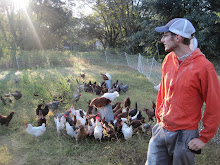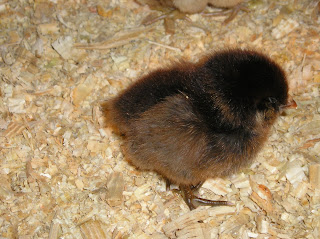




New farmers. Old values.










This Sunday was my first successful bake in my hand-built earthen mud oven. It was a traditional sourdough made with a starter of wild yeast which I've cultivated since my arrival here in Georgia mixed with whole rye and wheat flours. The firing took nearly three hours of maintaining an efficiently burning fire. I used pecan wood gathered from our orchard here. After about 20 minutes of baking we cut into two 2lb loaves that proved to be fantastically delicious and fresh.
Here's a photo of the oven. You can see it was a gorgeous day.
Let me detail a little bit about the process and principles behind the oven. The site had to be cleared of weeds and rubbish before I dug a small foundation. On top of that I built a support bricks stacked around a couple old tires. Inside the tires I piled rocks and cracked cement I found laying around for oven stability. Then I placed several layers if insulation consisting of wet clay mixed with sawdust on which to build the firebrick floor. On top of the firebrick I built a mound of oven mud, a mixture of clay and sand and water, a.k.a 'cob' which I mixed by foot. All in all the oven cost me $24 and a few days of hard but enjoyable work.
Here is the beginning fire, and as you can see it is small but bright. The beauty and challenge of cooking with an earth oven is ensuring high fuel efficiency. From only an armful of small twigs I was able to keep the fire stoked strong for over three hours for the firebrick and mud to hold heat thoroughly. The fire itself does not cook the sourdough, but rather the heat from the fire soaked into the material. Thus you must build with extremely porous but strong material. Clay has provided humanity with warm food for as long as we have known how to exploit fire. Whether burying food in the ground with hot coals or building an oven such as this, this process utilizes the beautiful and generous heat absorbing ability of one of earths most abundant resources.
Now comes the transformation at the heart of this traditional cooking method. The beginning, as with all life, is good soil. Here the wheat seed germinates producing, hopefully, a bountiful harvest. Given good soil, environmental and harvest conditions these seeds can be transformed into flour which, when combined with water, wild bacteria and yeast, creates the amazingly complex yet humble bread we know as sourdough.
Here is my sourdough after nearly a day of cultivation at room temperature. Here the dough is ready to be divided into loaves which are then allowed to sit while the oven is fired.
After the oven is fired and the heat has thoroughly soaked through the thermal mass, I let the hot coals sit for about one half hour in order that the heat inside the oven can equalize. The coals, especially at night, look like a little burning galaxy inside the dome.
Then finally, the most important transformation, the dough is placed inside the cleaned, heat soaked oven. There the wheat-water-yeast mass is heated at extremely high temperatures causing the yeast to explode, more or less. This causes the dough to rise into the fluffy, open texture that characterizes well-made bread.
I'm deeply grateful to have eaten and savored the fruit of such a patient, humble and traditional method of cooking. I know that I am participating in a long line of women and men who have taken wheat and water and time into their hands to give both nutrition and flavor to those they love. Indeed the very beginning of our 'civilization' as we know it 10,000 years ago in the Fertile Crescent was founded on people harvesting, grinding and cooking wheat.
Apart from the harvesting, transporting and grinding of the wheat, this process was completely fossil fuel and electricity free. I am saving money from selling the bread at market to buy my own hand powered mill to grind wheat which we grow ourselves. Until then, I will continue to learn from the oven and bread what real nourishment, art and patience are.

Friends-
Farming in the South has taught me that food is political. By design, obviously, it is first biological; the fruit of soil, rain and sun providing our bodies with nourishment for living.
In an economic structure that regards food as a basic need of life ,rather than a commodity, what we put in our bodies is also of principle importance in our society. Yet the great difference between our current market based system and a decentralized, fair-trade food economy is the alarming relationship which food now has to political power and violence.
In a matter of decades the worlds dominant cultures have revolted against once widespread viable networks of stable and diverse food production. In their place they have established a monoculture of eight industrialized crops to provide for 3/4 of the worlds food. This shift, though sudden, was not without dramatic and immediate consequences.
This drastic change resulted in a national food policy that forced family farmers to surrender their land if they could not compete with federally subsidized commercial crops grown for corporate profit. An astounding number of farmer suicides in the 1970's and 80's followed. This same process continues today in India where indigenous farmers are killing themselves at intolerable rates in reaction to global policies which drive down the price which the market will pay for their once valued products and labor.
Food is now another weapon in an undeclared but very real war on biological and cultural diversity that 'civilization' wages, or so it claims claim, to feed the hungry and bring stability to the 'developing' world. In reality, it is clear that international food policy, as dictated by groups like the World Trade Organization, is designed for the monetary benefit of a world-wide class of elites whose livelihood is derived from the exploitation of the land and those who bring forth its fruit.
According to food scientist and author Devinder Sharma, in the year 2008 alone riots broke out in over 37 countries to address the unequal distribution of food. We force other countries to import our over-produced and over-subsidized grains while demanding they accept a culture of serfdom in the place of once lively and beautiful local economies. Thus economically 'poorer' countries of the world are increasingly threatened with famine and social unrest.
The relationship between food and the political state of our world is impossible to overstate. Our current means of production and distribution with its inexhaustible need for petroleum is worsening the divide between ruling and exploited peoples. Under the current design, rich nations will continue to profit from the very process which is impoverishing rural cultures and soils worldwide.
A network of smaller economies committed to bringing health, nutrition and life from the soil for all people is needed now more than ever. If food continues to be exploited as commodity, poverty violence and hunger will grow as the wealthy classes continue to fight over increasingly scarce resources. It is exactly because food is so political that building bio-diverse food communities is now the work of freedom and the human right of cultural and culinary self-determination.






















